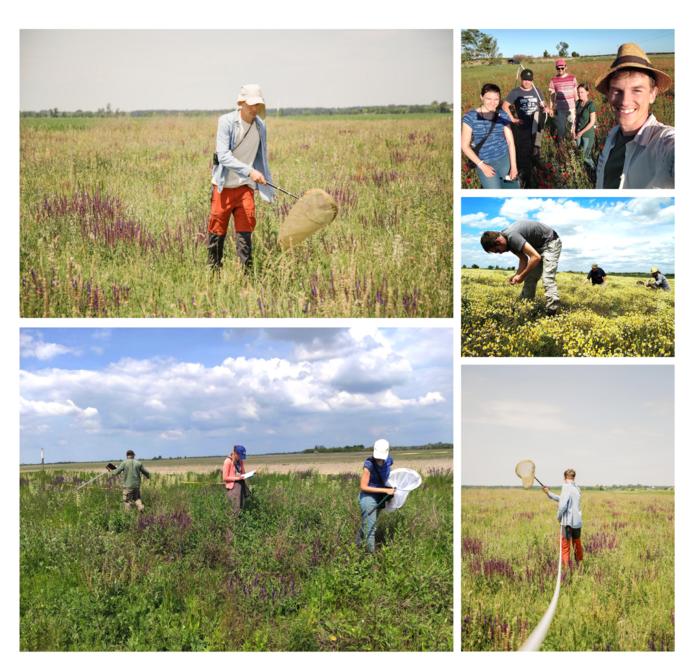Pollinators are declining rapidly, largely due to land conversion and intensification of agriculture. To mitigate their crisis, low-disturbance habitats, such as sown wildflower plantings (commonly known forms are wildflower strips at the edges of arable fields), could promote pollinators by restoration of their resources (food, sheltering and nesting habitats). However, comprehensive knowledge is lacking on how landscape context, spatial configuration and age of wildflower plantings, seasonality and flower composition affect pollinator communities, especially from East-Central Europe.

Credit: Photos: Borbála Bihaly (top left, buttom right) and Áron Bihaly (buttom left, middle and top right)
Pollinators are declining rapidly, largely due to land conversion and intensification of agriculture. To mitigate their crisis, low-disturbance habitats, such as sown wildflower plantings (commonly known forms are wildflower strips at the edges of arable fields), could promote pollinators by restoration of their resources (food, sheltering and nesting habitats). However, comprehensive knowledge is lacking on how landscape context, spatial configuration and age of wildflower plantings, seasonality and flower composition affect pollinator communities, especially from East-Central Europe.
To understand these effects, researchers from the HUN-REN Centre for Ecological Research, established diverse native wildflower plantings within heterogeneous and homogeneous agricultural landscapes, by two spatial configurations: one large field or three smaller strips. Floral resources and wild pollinator insects (wild bees, hoverflies, butterflies) were sampled, in early and mid-summer, for two years after establishment (2020-21).
Flower resources of the sown plant species increased continuously, and were complemented at high rate by flowering plant species from the soil seed bank, especially in the first year. Both flower abundance and diversity increased the abundance of pollinators, highlighting the important role of using diverse seed mixtures. Wild bee abundance and species richness increased year by year and season by season, while butterfly abundance also demonstrated a yearly increase after establishment. Hoverfly abundance and species richness, however, showed an opposite trend, possibly due to the inter-annual variation. Wild bee and butterfly abundance was higher in the heterogeneous than in the homogeneous landscapes. Researchers did not observe any significant local effects of spatial configuration itself on pollinator populations.
Wildflower plantings were particularly attractive for wild bees in flower-poor (homogeneous) landscapes during the flower-poor (mid-summer) period of the year. This can be explained by the increased contrast in flower resources between the wildflower plantings and the surrounding landscape, and highlights the importance of wildflower plantings in such conditions.
Our results emphasize that to support pollinators effectively, future wildflower plantings should be maintained for multiple years, in order to maximize floral diversity and ensure continuously available flower resources throughout the entire season. It can be facilitated by
i) Using diverse seed mixtures of native flowering plants,
ii) Particularly focusing on plants that bloom during the crucial mid-summer period,
iii) Allowing the plant species to grow and bloom from the soil seed bank, and
iv) Using management techniques, which help to extend the flowering season said Áron Bihaly corresponding author of the publication.
Further results from the upcoming years and similar long-term and landscape-scale experimental studies are needed to understand all the benefits and ecological processes of diverse native wildflower plantings especially in understudied European regions.
Journal
Agriculture Ecosystems & Environment
Method of Research
Experimental study
Subject of Research
Animals
Article Title
LANDSCAPE-WIDE FLORAL RESOURCE DEFICIT ENHANCES THE IMPORTANCE OF DIVERSE WILDFLOWER PLANTINGS FOR POLLINATORS IN FARMLANDS
Article Publication Date
29-Mar-2024
COI Statement
The authors declare that they have no known competing financial interests or personal relationships that could have appeared to influence the work reported in this paper.



